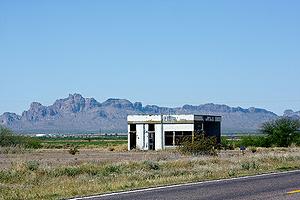Second Giant Solar Plant Planned for Arizona Electricity Users
PHOENIX, Arizona, May 25, 2009 (ENS) - A 290 million watt concentrating solar plant, among the largest in the world, is planned for construction in the Harquahala Valley, 75 miles west of Phoenix, the Arizona Public Service utility announced Friday.
Taking the podium at Arizona State University's Walter Cronkite School of Journalism, Arizona Public Service President and Chief Operating Officer Don Robinson said the giant solar plant will produce enough electricity to power more than 73,000 APS customer homes.
The event at ASU was the final stop on the utility's first solar tour of Arizona, staged to bring the message that APS is on the way to providing more solar electricity per customer than any other U.S. utility.
"It's always special to hit the road and get to meet the people in our state who are so committed to a better, sunnier, greener and cleaner Arizona," said Robinson, "We share a common passion for renewable energy here at APS."
Robinson said the utility wants to help make sunny Arizona the "solar capital of the world."
Scheduled for completion in 2013, the new solar power plant, dubbed Starwood Solar I, will be owned by an affiliate of Starwood Energy Group Global. All the electricity generated by the facility will be provided to Arizona Public Service through a long-term purchase power agreement.
 |
A view of the Harquahala Valley where Starwood Solar I will be built (Photo by Kevin Dooley) |
Starwood Solar I will be constructed on 1,900 acres in the Harquahala Valley. Its 3,500 parabolic mirrors will focus solar thermal energy onto a heat transfer fluid. The hot fluid will convert water into steam, which then turns the plant's turbines to create electricity, much like a traditional power plant.
The plant will use molten salt to store solar energy and continue producing electricity for up to six hours after the Sun goes down through the period of highest electricity usage during hot Arizona evenings.
"We are delighted to enter into such an important relationship with APS and the people of Arizona," said Brad Nordholm, chief executive of Starwood Energy. "Along with Lockheed Martin, we look forward to completing this project and providing cost-effective solar power for many decades."
Lockheed Martin, a global security company with systems integration expertise, will design, build and operate the facility.
"Lockheed Martin is very pleased to partner on the Starwood Solar I project," said Chris Myers, Lockheed Martin vice president for solar energy programs. "To drive to successful completion on this project, we are applying the kind of world-class systems engineering and disciplined integration approaches that all of our domestic and international customers enjoy."
Starwood Solar I is the second purchase power agreement by APS for energy from a concentrating solar plant. In February 2008, APS signed an agreement with the Spanish company Abengoa Solar for the power from the future Solana Solar Plant.
The Solana Generating Station is a 280-megawatt concentrating solar power plant to be built 70 miles southwest of Phoenix, near Gila Bend, Arizona. Scheduled to begin providing power in 2012, it will produce enough energy to serve 70,000 APS customers when operating at full capacity.
Starwood Solar I and Solana together will supply electricity to 143,000 consumers.
The first stop on the APS solar tour May 11 was held to offer Flagstaff customers the opportunity to help APS build an interconnected solar power plant – one rooftop at a time.
For this program, APS will own and receive energy from solar panels installed on about 300 customer rooftops. Participating customers will not have any up-front costs or other requirements and they will receive a low 20-year fixed community power rate for the solar portion of their electricity bill.
The second stop of the solar tour May 18 brought together two of the state's most recognizable features – the Grand Canyon and the Sun.
APS staffers celebrated with visitors as the Grand Canyon's Visitor Center went solar with 84 solar panels on the center's roof and on adjacent ground-mounted platforms.
The 18 kilowatts of energy generated by the panels provide enough power to offset 30 percent of the center's electricity use.
Robinson said that when planning the tour, the Grand Canyon was "a definite tour stop because of the opportunity that exists to educate more than 4.5 million Canyon visitors each year about renewable energy."
Copyright Environment News Service (ENS) 2009. All rights reserved.
To subscribe or visit go to: http://www.ens-newswire.com